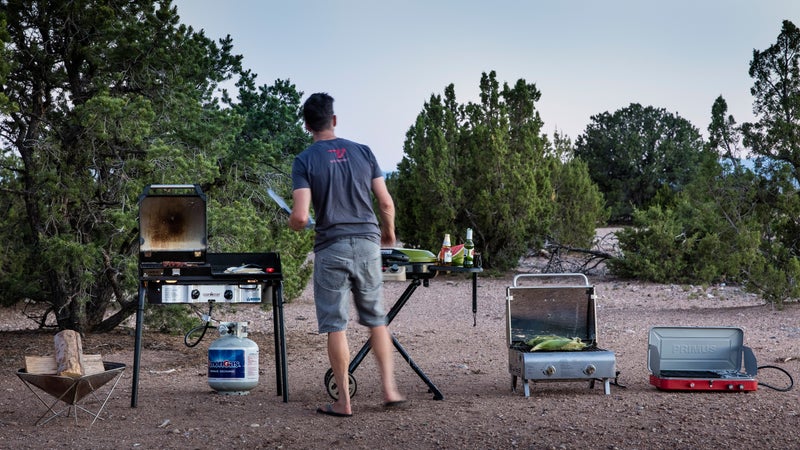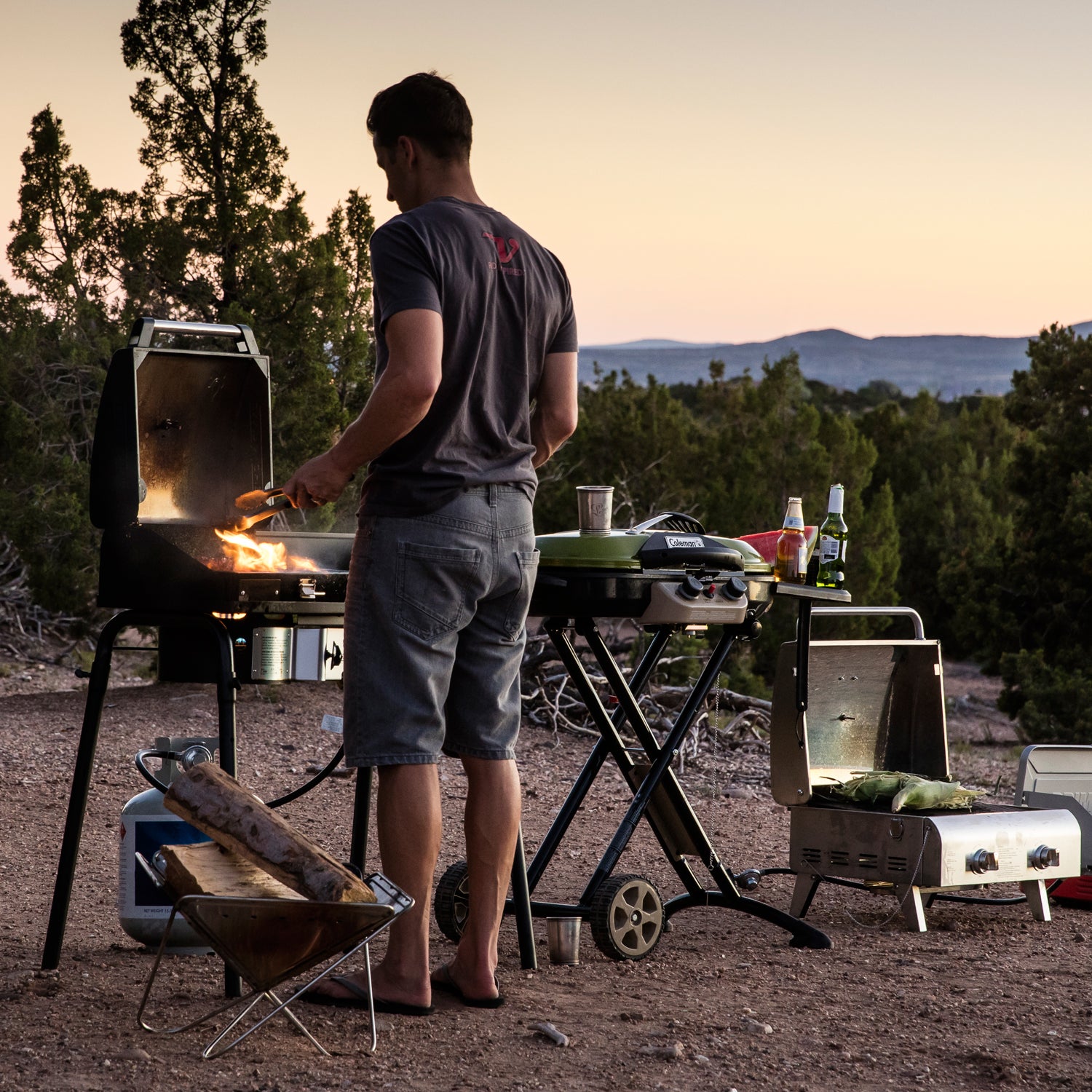“Never cook inside.” That was the admonishment of the previous owners of Artemis when they handed us the keys. The heat, grease, and lingering food odors weren’t worth it. In two years, they said, they’d never used the oven and only lit the stovetop for boiling water.
We thought they were fanatical—until we threw our first elk steaks on the cast iron skillet, on a May evening in Tucson after 90-degree highs earlier in the day. We spent the rest of the night trying to cool the trailer sufficiently to sleep and sweating till the wee hours.
So yeah, inside food prep isn’t always smart. (Although stovetop cooking is a great way to warm the trailer at cold, alpine campgrounds, we’ve found.) But beyond practicalities, grilling and eating under the stars is an integral part of what we enjoy about being on the road in the first place. If we wanted to cook and eat inside, it would be easier to stay home.
The Modern Nomad
 ���ܰ���guide to living on the road and spending more time outdoors—without quitting your job.
���ܰ���guide to living on the road and spending more time outdoors—without quitting your job.We started the grill search with one of the longest-standing companies in the business, Coleman. The only real differences between the ($200) and the limited National Parks editions we tested is color and branding, for which you pay a 15 percent markup—meaning the normal model is the way to go anyway. While this propane two-burner, which puts out 10,000 BTUs per side, has the most grilling space in the test (285 square inches), it is also the most mobile model, with a built-in rolling stand that scissors flat for easy setup and stowage. The push-button starter worked flawlessly, and grilling performance was solid, but not exceptional. The combination of the burners and grill-top didn’t regulate as well as we would have liked, so we often found ourselves grilling hot and flipping frequently.
If that were the biggest drawback, the X-cursion might still have won us over, but it was actually the thing that attracted us to the model in the first place—it’s mobility—that left us wanting. The swiveling design is awkward, and unfastening the legs, which can get a bit stuck and require some force to dislodge, resulted about half the time in a huge crashing to the ground, with flying grills and parts. It has also led to one broken handle, which was cheap to begin, and grates that no longer fit easily into place. In short, while this model grills fine and is sleek when it’s collapsed, the setup hassle and budget finishes meant the search continued.
Next up was the ($200), which looks similar to the Coleman on paper (propane, two 10,000 BTU grills, 277 inches of grilling space), but actually bears more resemblance to a high-end home appliance thanks to its stainless finish and solid feel. With a grill-top thermometer and deep-channeled grates that funnel grease into the easy-to-clean drip tray, this baby was the best cooker in the bunch. Though it doesn’t have as much raw power as the Camp Chef (below), the dome-shape design and relatively close quarters between grates and lid made for nice even cooking, and the regulator on the burners seemed to be the most sensitive in the test for micro-tuning. There’s also ample space for steaks, broccoli, and potatoes for four. The full-length metal handle didn’t heat up, the fold-up feet provided a stable platform and saved a bit of space, and, combined with the latching lid, it made for easy transport. Still, the Cuisinart is definitely one of the bulkier units we tried (22 pounds and somewhat bulbous) and therefore not ideal for minimalist setups. This is the grill for gourmands; not so much those just trying to get by.

After the first two units, we realized that it would be great to have something with a burner-grill combo because often we want to cook eggs while grilling sausage or pan-fry potatoes while grilling trout. So we turned to the ($240), which is actually an online-only amalgamation of three products: the Explorer Two-Burner Propane Stove, the Barbecue Grill Box 30, and the Pro Flat-Top Griddle. At over 60 pounds for all those parts (and 36 pounds for the stove alone), this is the bulkiest, least portable unit of them all. But if it cooked exceptionally—and we thought it might in light of the lid-top thermometer—the heft might not be a deal-breaker since we try to move only every week or two.
The dual 30,000 BTU burners are the most powerful we tried, and they were great for stove-top cooking, especially big pots for parties and groups. The Grill Box not so much, as the diffuser seemed too close to the grates and when grease dripped down from meat, it often caused flames to erupt, ending in carbonized BBQ chicken pucks a few times too many, even when we had the flame all the way down. The grill space was smaller than most, too, less than half of the overall 448-inches of cooking space, and we learned the hard way (e.g. red welts on the palms) that the box handle heats up so you need a mitt to open and close it. On the bright side, when we managed to avoid the flames, the grill was about the most even cooking from side to side. Still, while this would make a good setup for families and big groups (with very attentive grillers), thanks to its overall size and limitations, it’s not ideal for solo campers or couples.
Despite the Camp Chef’s hitches, we loved the grill-burner combo, so we sent away for the ($150), which has a similar form to the classic Coleman two-burner but combines a 12,000 BTU burner with a 10,000 BTU grill in burly shell. And despite the small grill space and lack of firepower, this unit exceeded our expectations. The burner isn’t as fast to heat as the ones in Artemis, but it’s sensitive enough to do everything from simmer hollandaise to sear a steak. And the grill, while only big enough for two people, is surprisingly even to cook, easy to regulate, and hasn’t had any problems with sticking. We’ve grilled elk steaks, pork chops, barbeque chicken, sausages, zucchini and squash, eggplant, and even kale, and all have turned out just how we wanted. It’s true that grilling on the Profile Dual takes a bit longer than on other units, and the lack of real estate would be tough for families, overall it was our favorite of the bunch, especially its diminutive size. It’s not as good a grill as the Cuisinart and not as good a cooker as the Camp Chef, but it’s probably the best compromise, especially if space is a constraint. We did find the propane attachment point tight and a bit hard to use, though we assume this will get easier as the port wears a little.
Being on the road constantly means lots of long evenings and quiet nights, and we’ve rediscovered—quite happily—the joy of charcoal grilling. After a few outings on campground grills, we decided to upgrade to the ($190) since the stationary ones can be rickety and trashed, and we only rarely stop at established campgrounds anyway. As with all Snow Peak products, the design here is beautiful and ingenious, with four hinged triangles of stainless steel that fold from flat (and easy to stow in the nylon carrying case) to an 18-inch square fire pit. The grate, for grilling, and base plate, for catching ashes, are sold separately ($50 and $30 respectively), making this the most expensive model in the test. Expensive? Yes. But not only is it the inverted pyramid the ultimate shape for building charcoal fires, it also doubles as a wood fire pit when the in-ground variety isn’t permitted. Steaks, ambiance, and s’mores! Moreover, Snow Peak designs are like Apple products: smart, high-function, and all around beautiful.
We like the Snow Peak so much that we’ve found ourselves grilling over charcoal more and more frequently as the options are more nuanced, the food tastes better, and the ritual of the process reinforces the whole idea of slowing down that we set out after in Artemis to begin. Grilling outside makes every meal feel like a picnic. And picnics are good for the soul.


